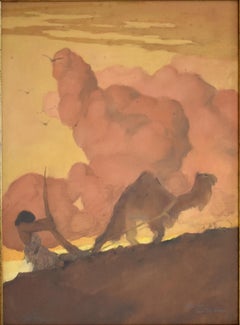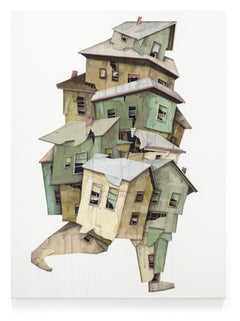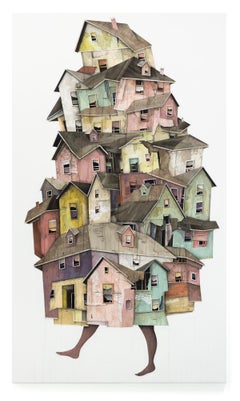Abel Pann Figurative Paintings
Russian, 1883-1963
“Over many years, Abel Pann (1883-1963) was regarded as the foremost Land Of Israel Painter. This view was shared by the Jewish community throughout the world and by the general public in pre-State Israel where reproductions of his works were hung in almost every home”. This is how Yigal Zalmone, Chief Art Curator of the Israel Museum, describes Abel Pann.
Abel Pann was born in 1883 in the town of Kreslawka in the Vitebsk region of White Russia. His father Nahum was a rabbi and head of a yeshiva, a religious academy. Pann received a Jewish elementary school education until he was twelve. He studied the fundamentals of drawing for three months with the painter Yehuda Pen of Vitebsk, who also taught Marc Chagall and Ossip Zadkine. When he was twelve he traveled between Russia and Poland, earning money as an apprentice in sign workshops. In 1898 he went south to Odessa, where he was accepted by the Academy of Fine Arts.
In 1903 Pann moved to Paris, where his work included depictions of Jewish daily life, Parisian genre paintings, as well as sketches and caricatures that were humorous and psychological criticisms regarding society. His empathy for the poor and wretched became well known.
In 1912, the director of the Bezalel School of Art and Crafts in Jerusalem asked Abel Pann to teach at the school which he accepted a year later.
During the first year of World War I, Pann was restricted to leave Europe after he returned to recover belongings to take back to Jerusalem. During the first years of the war, he concentrated on popular, nationalist posters and illustrations, including depictions of the cruelty of the German enemy.
In 1920 he returned to Jerusalem and resumed teaching at the Bezalel School, and formed the Palestine Art Publishing Company with which he used to print his albums of Bible illustrations. Abel Pann devoted much of his energy to these illustrations.
An interesting approach that Pann used in these illustrations was to depict the Biblical subjects using contemporary clothing and imagery. Using contemporary Middle Eastern characters in Oriental dress within local settings fulfilled the Zionist dream that the Jewish people were going to return to their homeland and renew their days of old.to
1
Overall Width
to
Overall Height
to
1
1
1
1
1
1
1
1
43
466
321
258
228
1
Artist: Abel Pann
Study for Cain was a Plowman - Pastel Russian Art
By Abel Pann
Located in London, GB
This work is hand signed in pencil by tha artist "Abel Pann" at the lower left corner.
It is also inscribed “Jerusalem” next to the signature.
The work is titled in French in pencil ...
Category
20th Century Abel Pann Figurative Paintings
Materials
Paper, Charcoal, Pastel
Related Items
"Wanderer 9" House Composition in Motion in Paint, Paper, and Charcoal
By Seth Clark
Located in Philadelphia, PA
This piece, titled "Wanderer 9" is an original artwork by Seth Clark as part of his newest solo exhibition, "Passing Through" and made of collage, charcoal, pastel, acrylic, and gra...
Category
21st Century and Contemporary Contemporary Abel Pann Figurative Paintings
Materials
Paper, Graphite, Acrylic, Pastel, Charcoal, Wood
"Wanderer 16" Architectural Composition in Collage, Acrylic and Graphite
By Seth Clark
Located in Philadelphia, PA
This piece, titled "Wanderer 16" is an original artwork by Seth Clark as part of his newest solo exhibition, "Passing Through". made of collage, charcoal, pastel, acrylic, and graphi...
Category
21st Century and Contemporary Contemporary Abel Pann Figurative Paintings
Materials
Paper, Wood, Charcoal, Pastel, Acrylic, Graphite
$14,000
H 72 in W 42 in
"Wanderer 11" Collapsing Houses in Ink Wash, Acrylic, and Collage by Seth Clark
By Seth Clark
Located in Philadelphia, PA
This piece, titled "Wanderer 11" is an original artwork by Seth Clark as part of his newest solo exhibition, "Passing Through" and is made of collage, charcoal, pastel, acrylic, and...
Category
21st Century and Contemporary Contemporary Abel Pann Figurative Paintings
Materials
Paper, Graphite, Acrylic, Pastel, Charcoal, Wood
"Wanderer 13"
By Seth Clark
Located in Philadelphia, PA
This piece, titled "Wanderer 13" is an original artwork by Seth Clark as part of his newest solo exhibition, "Passing Through", made of collage, charcoal, pastel, acrylic, and graph...
Category
21st Century and Contemporary Contemporary Abel Pann Figurative Paintings
Materials
Paper, Wood, Charcoal, Pastel, Acrylic, Graphite
"Wanderer Study 2" Acrylic, Pastel and Collaged Painting of Moving House
By Seth Clark
Located in Philadelphia, PA
This piece, titled "Wanderer Study 2"is an original artwork by Seth Clark as part of his newest solo exhibition, "Passing Through". made of collage, charcoal, pastel, acrylic, and gr...
Category
21st Century and Contemporary Contemporary Abel Pann Figurative Paintings
Materials
Wood, Paper, Charcoal, Pastel, Acrylic, Graphite
"Wanderer 10" Architectural Assemblage in Collage Paper Textures and Paint Drips
By Seth Clark
Located in Philadelphia, PA
This piece, titled "Wanderer 10" is an original artwork by Seth Clark as part of his newest solo exhibition, "Passing Through" is made of collage, charcoal, pastel, acrylic, and gra...
Category
21st Century and Contemporary Contemporary Abel Pann Figurative Paintings
Materials
Paper, Graphite, Acrylic, Pastel, Charcoal, Wood
"The Meeting 20"
By Seth Clark
Located in Philadelphia, PA
This piece, titled "The Meeting 20" is an original artwork by Seth Clark as part of his newest solo exhibition, "Passing Through". made of ink transfer, charcoal, pastel, acrylic, an...
Category
21st Century and Contemporary Contemporary Abel Pann Figurative Paintings
Materials
Wood, Paper, Charcoal, Pastel, Acrylic, Graphite
"The Meeting 29" Ink Transfer and Pastel Architectural Figure by Seth Clark
By Seth Clark
Located in Philadelphia, PA
This piece, titled "The Meeting 29" is an original artwork by Seth Clark as part of his newest solo exhibition, "Passing Through". made of ink transfer, charcoal, pastel, acrylic, an...
Category
21st Century and Contemporary Contemporary Abel Pann Figurative Paintings
Materials
Wood, Paper, Charcoal, Pastel, Acrylic, Graphite
Rare Modernist Hungarian Rabbi Pastel Drawing Gouache Painting Judaica Art Deco
By Hugó Scheiber
Located in Surfside, FL
Rabbi in the synagogue at prayer wearing tallit and tefillin.
Hugó Scheiber (born 29 September 1873 in Budapest – died there 7 March 1950) was a Hungarian modernist painter.
Hugo Scheiber was brought from Budapest to Vienna at the age of eight where his father worked as a sign painter for the Prater Theater. At fifteen, he returned with his family to Budapest and began working during the day to help support them and attending painting classes at the School of Design in the evening, where Henrik Papp was one of his teachers. He completed his studies in 1900. His work was at first in a post-Impressionistic style but from 1910 onward showed his increasing interest in German Expressionism and Futurism. This made it of little interest to the conservative Hungarian art establishment.
However, in 1915 he met the great Italian avant-gardist Filippo Tommaso Marinetti and the two painters became close friends. Marinetti invited him to join the Futurist Movement. The uniquely modernist style that he developed was, however, closer to German Expressionism than to Futurism and eventually drifted toward an international art deco manner similar to Erté's. In 1919, he and his friend Béla Kádar held an exhibition at the Hevesy Salon in Vienna. It was a great success and at last caused the Budapest Art Museum to acquire some of Scheiber's drawings. Encouraged, Scheiber came back to live in Vienna in 1920.
A turning point in Scheiber's career came a year later, when Herwarth Walden, founder of Germany's leading avant-garde periodical, Der Sturm, and of the Sturm Gallery in Berlin, became interested in Scheiber's work. Scheiber moved to Berlin in 1922, and his paintings soon appeared regularly in Walden's magazine and elsewhere. Exhibitions of his work followed in London, Rome, La Paz, and New York.
Scheiber's move to Germany coincided with a significant exodus of Hungarian artists to Berlin, including Laszlo Moholy-Nagy and Sandor Bortnyik. There had been a major split in ideology among the Hungarian avant-garde. The Constructivist and leader of the Hungarian avantgarde, Lajos Kassák (painted by Hugó Scheiber in 1930) believed that art should relate to all the needs of contemporary humankind. Thus he refused to compromise the purity of his style to reflect the demands of either the ruling class or socialists and communists. The other camp believed that an artist should be a figurehead for social and political change.
The fall out and factions that resulted from this politicisation resulted in most of the Hungarian avant gardists leaving Vienna for Berlin. Hungarian émigrés made up one of the largest minority groups in the German capital and the influx of their painters had a significant effect on Hungarian and international art. Another turning point of Scheiber's career came in 1926, with the New York exhibition of the Société Anonyme, organized by Katherine Dreier. Scheiber and other important avant garde artists from more than twenty-three countries were represented. In 1933, Scheiber was invited by Marinetti to participate in the great meeting of the Futurists held in Rome in late April 1933, Mostra Nazionale d’Arte Futurista where he was received with great enthusiasm. Gradually, the Hungarian artists began to return home, particularly with the rise of Nazism in Germany. Kádar went back from Berlin in about 1932 and Scheiber followed in 1934.
He was then at the peak of his powers and had a special flair in depicting café and cabaret life in vivid colors, sturdily abstracted forms and spontaneous brush strokes. Scheiber depicted cosmopolitan modern life using stylized shapes and expressive colors. His preferred subjects were cabaret and street scenes, jazz musicians, flappers, and a series of self-portraits (usually with a cigar). his principal media being gouache and oil. He was a member of the prestigious New Society of Artists (KUT—Képzőművészek Új Társasága)and seems to have weathered Hungary's post–World War II transition to state-communism without difficulty. He continued to be well regarded, eventually even receiving the posthumous honor of having one of his images used for a Russian Soviet postage stamp (see image above). Hugó Scheiber died in Budapest in 1950.
Paintings by Hugó Scheiber form part of permanent museum collections in Budapest (Hungarian National Museum), Pecs (Jannus Pannonius Museum), Vienna, New York, Bern and elsewhere. His work has also been shown in many important exhibitions, including:
"The Nell Walden Collection," Kunsthaus Zürich (1945)
"Collection of the Société Anonyme," Yale University Art Gallery, New Haven, Connecticut (1950)
"Hugó Scheiber: A Commemorative Exhibition," Hungarian National Museum, Budapest (1964)
"Ungarische Avantgarde," Galleria del Levante, Munich (1971)
"Paris-Berlin 1900-1930," Centre Georges Pompidou, Paris (1978)
"L’Art en Hongrie, 1905-1920," Musée d’Art et l’Industrie, Saint-Etienne (1980)
"Ungarische Avantgarde in der Weimarer Republik," Marburg (1986)
"Modernizmus," Eresz & Maklary Gallery, Budapest (2006)
"Hugó Scheiber & Béla Kádár," Galerie le Minotaure, Paris and Tel Aviv (2007)
Hugó Scheiber's paintings continue to be regularly sold at Sotheby's, Christie's, Gillen's Arts (London), Papillon Gallery (Los Angeles) and other auction houses.
He was included in the exhibition The Art Of Modern Hungary 1931 and other exhibitions along with Vilmos Novak Aba, Count Julius Batthyany, Pal Bor, Bela Buky, Denes Csanky, Istvan Csok, Bela Czobel, Peter Di Gabor, Bela Ivanyi Grunwald, Baron Ferenc Hatvany, Lipot Herman, Odon Marffy, C. Pal Molnar...
Category
Early 20th Century Modern Abel Pann Figurative Paintings
Materials
Paper, Charcoal, Pastel, Watercolor, Gouache
$5,500
H 15.75 in W 14.5 in
"House Studies Series II", Layered Paper and Drawing Collage, Architecture
By Seth Clark
Located in Philadelphia, PA
This layered paper and drawing collage titled "House Studies Series II" is an original artwork by Seth Clark made of paper, charcoal, pastel, graphite, and acrylic on wood. Through a...
Category
21st Century and Contemporary Contemporary Abel Pann Figurative Paintings
Materials
Paper, Charcoal, Pastel, Acrylic, Wood Panel, Graphite
"The Meeting 26" Painting with Ink Transfer, Charcoal, Graphite and Pastel
By Seth Clark
Located in Philadelphia, PA
This piece, titled "The Meeting 26" is an original artwork by Seth Clark as part of his newest solo exhibition, "Passing Through". made of ink transfer, charcoal, pastel, acrylic, a...
Category
21st Century and Contemporary Contemporary Abel Pann Figurative Paintings
Materials
Wood, Paper, Charcoal, Pastel, Acrylic, Graphite
"House Studies Series V", Layered Paper and Drawing Collage, Architectural
By Seth Clark
Located in Philadelphia, PA
This layered paper and drawing collage titled "House Studies Series V" is an original artwork by Seth Clark made of paper, charcoal, pastel, graphite, and acrylic on wood. Through a ...
Category
21st Century and Contemporary Contemporary Abel Pann Figurative Paintings
Materials
Paper, Graphite, Wood, Charcoal, Pastel, Mixed Media, Acrylic
Abel Pann figurative paintings for sale on 1stDibs.
Find a wide variety of authentic Abel Pann figurative paintings available for sale on 1stDibs. You can also browse by medium to find art by Abel Pann in charcoal, crayon, paper and more. Not every interior allows for large Abel Pann figurative paintings, so small editions measuring 19 inches across are available. Customers who are interested in this artist might also find the work of Pavel Polanski, Gleb Savinov, and Maya KOPITZEVA. Abel Pann figurative paintings prices can differ depending upon medium, time period and other attributes. On 1stDibs, the price for these items starts at $9,400 and tops out at $9,400, while the average work can sell for $9,400.


